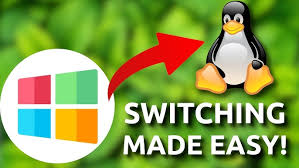How to Overcome the Learning Curve When Switching from Windows to Linux
Introduction
How to switch from Windows to Linux is a common question among users interested in open-source operating systems. Linux offers great flexibility and customization, but the transition can feel challenging. This guide will help you overcome the initial learning curve and ease into Linux.
Why Make the Switch to Linux?
Switching from Windows to Linux comes with numerous benefits, such as better security, enhanced privacy, and improved control over your system. Linux also allows users to access an extensive selection of free software and tools, making it ideal for developers, tech enthusiasts, and those seeking a customizable OS.
Understand the Differences Between Windows and Linux
File Structure
Linux has a different file structure than Windows, where everything is organized in a hierarchical tree structure. Unlike Windows, which uses drive letters, Linux starts with the root directory (/) and branches out.
- Tip: Familiarize yourself with basic Linux directories like
/home,/etc, and/usrto understand file organization.
Software Management
Linux uses package managers to install and update software, which is different from Windows. Each Linux distribution has its own package manager, like apt for Ubuntu or yum for Fedora.
- Tip: Learning to use the package manager in your chosen distribution is essential for easy software management.
Command-Line Usage
Linux relies more heavily on the command line, though many Linux distributions offer graphical interfaces. Learning basic commands will significantly ease the transition.
- Tip: Start by learning simple commands like
ls,cd,mkdir, andsudoto navigate and manage files.
Choose the Right Linux Distribution
Different Linux distributions, or “distros,” cater to different user needs. Choosing the right one can make the transition from Windows smoother.
Ubuntu
Ubuntu is one of the most user-friendly Linux distributions. It has a vast support community, making it perfect for beginners.
Linux Mint
Linux Mint is often recommended for Windows users due to its similar interface and ease of use.
Fedora
Fedora offers the latest software updates and tools, making it ideal for users interested in innovation.
- Tip: Research each distribution and start with one designed for beginners, like Ubuntu or Linux Mint.
Familiarize Yourself with the Linux Desktop Environment
Linux offers multiple desktop environments (DEs), unlike Windows, which has a single interface. Some popular DEs include GNOME, KDE, and XFCE.
-
GNOME: Known for its modern and minimalist design.
-
KDE Plasma: Similar to Windows with a customizable interface.
-
XFCE: Lightweight and fast, ideal for older hardware.
-
Tip: Choose a DE that feels comfortable and explore its settings to find what works best for you.
Start with Simple Daily Tasks
Rather than jumping into complex tasks, start with simple ones to get comfortable.
Basic Navigation
Explore your file manager, connect to Wi-Fi, and configure your settings. Performing these basic tasks will help you become more familiar with the environment.
Installing Software
Experiment with installing new software through your package manager. For instance, try installing familiar applications like Firefox, LibreOffice, or VLC.
- Tip: Use the Software Center or package manager to find and install applications.
Seek Out Resources and Support
The Linux community is known for its helpfulness. Take advantage of resources available to Linux users.
Online Forums and Communities
Websites like Ask Ubuntu, LinuxQuestions, and Reddit have active communities ready to help with common issues.
- Tip: Join a forum relevant to your Linux distribution to ask questions and read about other users’ experiences.
Online Tutorials and Courses
Platforms like YouTube, Coursera, and Udemy offer beginner-friendly tutorials for transitioning to Linux. Many of these resources are free.
Practice Command-Line Basics Gradually
Though Linux can be used without the command line, learning it adds efficiency.
Start with Basic Commands
Begin with simple commands like ls to list files, cd to change directories, and cp to copy files.
- Tip: Create a “cheat sheet” of essential commands to keep by your side as you learn.
Explore Shell Scripting
Once comfortable, delve into basic shell scripting. This will help automate tasks and make your experience more productive.
- Tip: Try small projects, like creating a script to back up files, to build confidence.
Customize Your Linux Setup
Linux allows extensive customization, so take advantage of it to create an environment that feels comfortable.
Adjust Themes and Icons
Many Linux distros let you customize the look and feel with themes and icon packs. Choose a theme that resembles Windows to make the transition smoother.
Set Up Keyboard Shortcuts
Configure keyboard shortcuts for frequent actions. This will make navigation faster and more intuitive.
- Tip: Experiment with small changes to find what works best for you.
Embrace the Learning Process
Switching from Windows to Linux takes time and patience. Don’t get discouraged by minor challenges, as the benefits are worth the effort.
Expect a Learning Curve
Accept that Linux operates differently from Windows. Patience and a willingness to learn will make the transition much easier.
Celebrate Small Wins
Every task you complete successfully is progress. Celebrate mastering new commands or successfully installing software.
- Tip: Keep a journal of what you learn each day to track your progress and stay motivated.
Conclusion
Switching from Windows to Linux can seem daunting, but it’s manageable with the right approach. By understanding the basics, choosing a user-friendly distro, and embracing the learning process, you’ll find yourself comfortably navigating Linux in no time. Remember, learning how to switch from Windows to Linux is a journey, and with patience and persistence, you’ll soon appreciate Linux’s power and flexibility.




